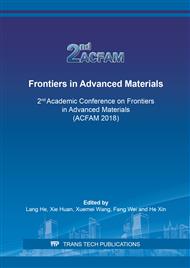[1]
K.K. Koo, T. Inoue, K. Miyasaka, Toughened plastic consisting of brittle particles and ductile matrix, Polym. Eng. Sci. 25 (1985) 741-746.
DOI: 10.1002/pen.760251203
Google Scholar
[2]
D. Li, Z. Qi, The fracture toughness CaCO3 reinforced polypropylene composite, Polym. Mater. Sci. Eng. 7(2) (1991) 18-25.
Google Scholar
[3]
J. Feng, M. Chen, Advance in polymers toughened by rigid inorganic particles, China Plastics. 14(11) (2000) 10-15.
Google Scholar
[4]
M. Si, J. Hao, L. Xu, Analysis of nano-Sb2O3 in flame retardancy applications, China Plastics. 27(8) (2013) 1-7.
Google Scholar
[5]
X. Luo, M. He, J. Guo, Study on long glass fiber reinforced polypropylene composites based on complex flame retardant of DBDPE-Sb2O3, China Plast. Ind. 12(21) (2013) 75-80.
Google Scholar
[6]
Y. Zheng, B. Wang, Study on the properties of TiO2/epoxy nano-composites, Acta. Polym. Sin. 19(4) (2002) 11-13.
Google Scholar
[7]
M.Z. Rong, M.Q. Zhang, Y.X. Zheng, Improvement of tensile properties of nano-SiO2/PP composites unrelate onto percolation mechanism, Polymer. 42(1) (2001) 3301-3304.
DOI: 10.1016/s0032-3861(00)00741-2
Google Scholar
[8]
X. Xu, Y. Zhang, B. Li, Mechanical and thermal properties of nano-SiO2/PA66 composites, Acta. Polym. Sin. 24(4) (2008) 56-62.
Google Scholar
[9]
W.C.J. Zuiderduin, C. Westzaan, J. Huetink, Toughening of polypropylene with calcium carbonate particles, Polymer. 44 (2003) 261-275.
DOI: 10.1016/s0032-3861(02)00769-3
Google Scholar
[10]
Z. Bai, S. Zhen, H. Shen, Preparation of antimony trioxide-wollaston composite filler and its application in polypropylene, China Powd. Sci. Tec. 4(2) (2010) 54-57.
Google Scholar
[11]
X. Ren, L. Bai, G. Wang, Reinforcement and to ushering of polypropylene composites by nano-particle CaCO3, Chemical World. 83(2) (2000) 83-87.
Google Scholar
[12]
G. Ji, J. Tao, T. Wang, Investigation on the mechanical properties of nano-TiO2/PP composites, Acta. Polym. Sin. 22(5) (2005) 100-106.
Google Scholar
[13]
J. Liu, X. Hao, Polymer based nano-modified materials. Sci. Technol. Press, Beijing, (2009).
Google Scholar
[14]
J. Sun, Y. Huang, H. Cao, Effects of surface treatment of CO3O4 nano-particles on the properties of their nanocomposites, Acta Polym. Sin. 21(3) (2004) 33-37.
Google Scholar
[15]
X. Jiang, Y. Zhang, Y. Zhang, Crystallization behaviour of dynamicall cured polypropylene/ epoxy blends, J. Polym. Sci. Pol. Phys. 42 (2004) 1181- 1191.
DOI: 10.1002/polb.10759
Google Scholar
[16]
K. Ozazwa, Y. Sakka, M. Amano, Perparation and eletrical conductivity of three types of antimonic acid films, J. Mater. Res. 13 (1998) 830-833.
DOI: 10.1557/jmr.1998.0107
Google Scholar


